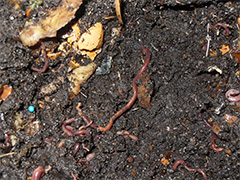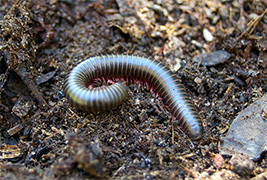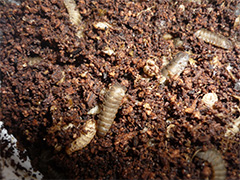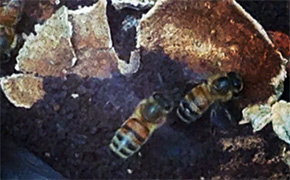Compost critters and what they can tell you
- Butler SWCD
- Dec 6, 2019
- 4 min read

Ok, the critters in your compost are not going to be whispering sweet nothings in your ear, but they can tell us a lot about our compost's conditions. When we check our compost, there are many animals we can expect to find such as millipedes and worms, and the microscopic bacteria. After all, we wouldn't have our compost without these hard working individuals. When populations start to become unbalanced, this is them quietly telling you something isn't quite right with your compost bin. There are also numerous other animals that can unexpectedly call your compost bin their home.
Pill bugs, sow bugs
Pill bugs (roly- polies) and sow bugs are regularly found in compost because their primary food source is decaying plant material, although they will occasionally eat live plants. It's great to find some in your compost, but too many of them might indicate that moisture levels are too high. Mix your compost and refrain from watering it to give it a chance to dry out.
Fun fact: These land-dwelling crustaceans that are closely related to shrimp and crabs.
Ants
There are thousands of species of ants, all with their own food preferences. Some are tiny predators, while others are seed feeders or even omnivores that consume anything and everything they can find. Although ants are generally no cause for worry, simply serving as decomposers and aerators, their presence often indicates a few things about your compost. Either, you are not turning your pile frequently enough or that it might be too dry. Hot, actively “cooking” compost piles are not a welcome place for an ant colony. Be sure to turn your pile every few weeks and to maintain the moisture level to that of a wrung-out sponge. Apparently, ants can make compost richer in phosphorus and potassium by moving minerals around as they work.
Centipedes and millipedes
Although often confused, millipedes and centipedes are quite different from each other. Millipedes are scavengers and eat mostly decayed plant material. Centipedes are predators. they have a pair of poison-infused modified claws near their mouth that can “sting” humans if they are handled roughly, although, in most species, these claws are not strong enough to pierce human flesh.
Millipedes are your friend in compost, they play an important role breaking down organic matter and creating tunnels through which microbes can readily move around the pile. Centipedes eat various insects, spiders, slugs, and worms in the compost pile. If you find large numbers of centipedes, this often indicates that the pile is too wet. Unlike millipedes, centipedes do not have a waxy covering over their skin, so they need moisture to survive.
Flies
Flies are a diverse crew, and can be found in adult or juvenile (larval/maggot) form. The presence of a large number of flies might indicate that you are adding inappropriate items to your compost, or that you need to bury food. Carrion-eating species are attracted to meat, so never add meat products to your pile. Burying all kitchen scraps 6 to 8 inches deep, in fact, helps reduce all manner of flies in the compost pile. The most common fly species in compost is probably the black soldier fly (Hermetia illucens). Its large, plump, cream-colored maggots are noticeable and might cause some alarm when first discovered. Finding them in your pile isn’t a big deal, except for the yuck factor. These maggots prefer moist compost piles, so adding more carbon-rich brown ingredients to dry out the pile and burying your kitchen scraps should be enough to deter them. Mites help to keep fly larvae reduced in numbers.
Worms
Earthworms are the most important of the large physical decomposers in a compost pile. Earthworms ingest organic matter and digest it with the help of tiny stones in their gizzards. Their intestinal juices are rich in hormones, enzymes, and other fermenting substances that continue the breakdown process. The worms leave dark, fertile castings behind. A worm can produce its weight in castings each day. These castings are rich in plant nutrients such as nitrogen, calcium, magnesium, and phosphorus that might otherwise be unavailable to plants. Earthworms thrive on compost and contribute greatly to its quality. The presence of earthworms in either compost or soil is evidence of good microbial activity.
Bees
Although it is rare for European honeybees to build a comb inside a compost bin, sometimes gardeners might encounter some smaller species of native bees hanging out in a compost pile, particularly those that build their brood chambers in hollow plant stalks. North America is home to nearly 4,000 species of native bees, most of which live docile and solitary lives, nesting in hollow twigs, wood tunnels, or excavated ground burrows. Sometimes certain native bee species will take up residence in the discarded perennial or bramble stems on top of a compost pile. These small nondescript bees are suffering from pesticide exposure and habitat loss—just as the imported European honeybees are—so allowing them to reside in your compost pile is a good thing. Most, by the way, do not sting.
Yellow Jackets
Don't mistake these wasps as bees. The social, ground-dwelling species of yellow jackets, which sometimes take up residence in compost piles and bins, are, in fact, commonly called “ground bees,” although they are actually wasps. They can become rather aggressive in fall, stinging repeatedly. Ground-dwelling yellow jackets can become problematic in the compost pile if they decide to build a nest there.
By regularly turning the pile, starting in early spring, this will prevent yellow jackets from building a nest. If it's too late, and a nest is established, use commercial traps to capture them or leave the compost pile alone until the following year, when the abandoned nest can be safely removed. Make sure not to spray an insecticide, this will kill many of the beneficial insects in your compost.

































